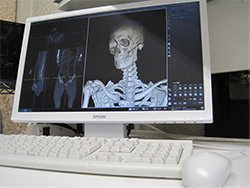Estimation of age at death by using multidetector computed tomography images
When an unidentified body is found, it is necessary to determine its identity. Currently, fingerprints, dental records, and DNA analysis are the main methods of identification; age and sex are also determined by such as bone assessment. Traditionally, the age at death was estimated by macroscopically examining teeth and dry bones. Although performing relatively accurate age estimation in young individuals is possible by examining tooth emergence patterns, estimating the age at death of adult individuals, particularly after middle-age adults, remains challenging.
The macroscopic assessment of bones involves the time-consuming and effort-intensive procedure of removing soft tissue. In our department, we perform whole-body computed tomography (CT) before autopsy in all cases, and these CT images allow us to easily collate bone-related information of the entire body. Non-destructive evaluation of cross-sectional images is also possible using this technique. CT images need lesser storage space than dry bones and allow repeated measurement and evaluation. Using these advantages of CT images, we aim to study a new method of age estimation and to examine whether information the traditional macroscopic assessment method can be replaced with CT images.
Fumiko Chiba

